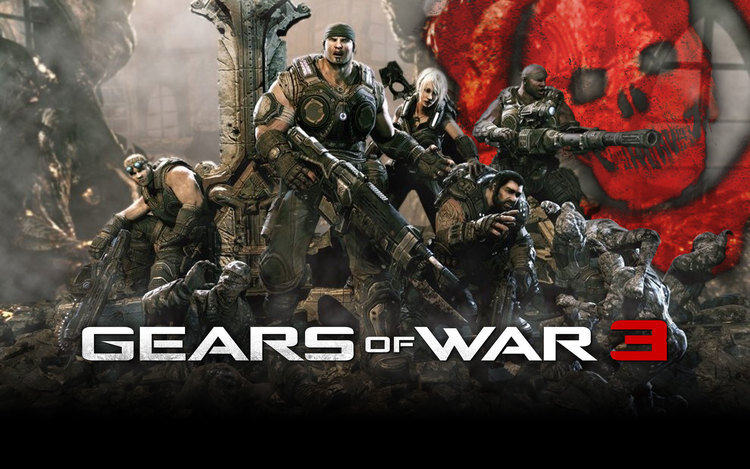Video games can be fascinating, a fantastic way to avoid reality with great potential for a hell of a lot of fun, but like many dopamine transmitters, games can get you into trouble if you have a hard time achieving moderation. Under the right circumstances, a video game habit can spiral out of control, as it did for Tom Bissell, whose 2010 essay in the Guardian is the best I’ve ever read on the pleasures and sorrows of video games and addiction. He went on to write more about gaming in his excellent book Extra Lives: Why Video Games Matter and has managed since to segue into writing the games themselves, including the recent third-person shooter, Gears of War: Judgment.
Though it’s enthusiastic and punctuated by a few new games every year, my gaming habit never approached the level of “addiction” Bissell describes in his entertaining article and these days mostly consists of sitting in front of my Xbox 360 once a week or so, with a handful of real-world friends who are spread across a few different states. On this weekly adventure, my friends and I are virtually shooting, running, ducking, diving, fighting, blowing stuff up, rescuing injured pals on the battlefield or generally saving the world for a couple hours of territory defense before I’m ready to call it a night. Although I’m a fan of Bissell’s writing and share his love for revisiting the perfect game repeatedly…alas, Tom, my favorite game isn’t Grand Theft Auto.
It’s Epic Games’ 2011 futuristic science fiction post-apocalyptic hit Gears of War 3, which pits a scrappy international army of overly muscled humans (who curiously never break for the weight room or to quaff a protein shake but nonetheless waddle around, perma-swollen under their immense, rippled muscle masses like a diverse assortment of heavily armed Lou Ferrigno clones) to battle a horrifying array of evil monsters from underground known as the Locust Horde, who will stop at nothing to murder every last one of us in the most terrifying of ways.
At this low point for humanity, there doesn’t seem to be much left to fight for on planet Sera, but it all looks spectacular anyway, as in previous installments. This time around, there’s a big boat with a veggie garden and vending machines, and some big-wheeled battle trucks, along with plenty of burned-out and broken-down buildings rendered beautifully in their magnificent desolation.
Unlike many futuristic sci-fi scenarios in games, films, books, comics and elsewhere, these future-human bull-necked men (and a few equally tough but less-ridiculously inflated women) don’t shoot laser beams. They rely on ballistic weapons that fire bullets, kick wildly, are prone to jamming and overheating, and often go empty. It is this grounding in the visceral, tactile weaponry and the sensation of slamming an oversize, armored soldier into cover amid a hail of enemy fire that makes the Gears franchise seem more real, despite all the action-hero muscles that oddly don’t require breaks to consume 24 chicken breasts daily. Oh, and an assault rifle with a chainsaw mounted on it doesn’t sound all that realistic, but trust me, it rules.
In Gears, nobody pilots a spaceship or floats around in outer space. Nobody jumps and shoots at you while gliding through the air, mid-jump, either. In the Gears world, character models and environments carry a physical weight that can be felt with every move. Defending a pathetic little outpost with a small squad against increasingly desperate odds, shoulder to shoulder with buddies, relying on each other to help recover when each are knocked down and bleeding out…battling back the Horde of scary monsters for the absolute survival of the human species (instead of yet another depressing, dehumanizing human-versus-human war) never gets old.
Horde mode, a game variant first introduced in 2008 with the release of Gears of War 2, when my friends and I originally embraced it, got even better with the release of Gears 3 in 2011, adding a monetized reward system with expandable defensive fortifications like caltrops, razor wire, laser gates, turrets, sentries, decoys, mechanized attack suits and upgradable air support.
Horde pits a small squad of up to five Gears soldiers (AKA Cogs), fighting desperately and cooperatively to survive, to protect the last semblance of human life on Sera by defending dwindling territories (and each other) against a merciless horde of marauding, vicious, computer-controlled monsters who moan, groan and growl on approach. Some can briefly paralyze a Cog merely by shrieking into his or her face.
Shooting at Cogs with pistols, rifles, shotguns, flamethrowers, explosive arrows, “boomshots” (an apt description), missiles and satellite-guided firebombs; swinging explosive ball-and-chain or oversized meat cleaver melee weapons straight out of a Clive Barker novel at close range; lobbing incendiary, poisonous ink and fragmentation grenades; hurling car-sized blobs of liquid fire and striving unrelentingly to get close enough to literally stomp our skulls into messy pieces of gore, the Locust Horde can really bring a few friends together.
My small group of married 30-something buddies all work full-time and convene online wearing bulky headphones that allow us to chat as we each sit alone in darkened rooms, connected by our Xbox 360s via the innerwebs, drinking beers and making each other laugh as we battle the Horde together, a band of brothers at virtual arms, our wives occasionally walking by to laugh at us as we yell into our headsets:
Who’s got frags? Grinder! We need a frag here! Zerkers again? I HATE those guys! Somebody get to the Hammer of Dawn! Flamer coming up the stairs! Get that Kantus on the left! Must…reach…Hammer…of…Dawn. I’m down over here! Since when do Brumaks walk through walls? WTF? This underground "digger" gun is total bullshit! It’s ruining the whole retro ballistics aesthetic! Who’s got $200 for razor wire? Get the Silverback! Mauler on the stairs!
You get the idea. Yes, Gears 3 is a lot better than the more recent game in the series (Judgment)—though this is no fault of Bissell’s. Having entirely eliminated our favorite game mode (Horde) with its simple, elegant design and replacing it with the messy, chaotic Over Run and Survival modes, with Judgment, Epic (or perhaps its subsidiary development studio) has failed us.
After playing through Judgment’s new campaign and wrestling with its new multiplayer and co-op modes for a while, my Horde Team sold all our copies and switched back in frustration to Gears 3, but we continue to thoroughly enjoy the older game, hording away together across state lines once a week. I wrote to Epic to let them know just how surprised and disappointed we were with Judgment and how we’d all reverted back to Gears 3. I suggested that they consider releasing an "Epic Horde Edition" of the Gears franchise, including every Horde map that has appeared in all the games, with the fortification systems from Gears 3.
This would allow Horde maniacs like us to take in all the different scenery from the entire series on every map while enjoying the best cooperative game mode around. Plus, Epic wouldn't have to build another campaign for this edition, so this would keep development costs down. The content is already there; it just needs to be combined into one edition for retail (and/or download), and the price would presumably be lower for us, too.
Epic wrote me back recently, saying simply that they had “nothing to announce” regarding Horde.
In the end, what’s essential about Horde is that it’s co-op. We’re friends in real life. It’s not a competition against each other. We’re a team fighting against the computer and helping each other out along the way. We’re not jumping into a randomized online competition with a bunch of racist, homophobic pre-teens who will most certainly pound our geezer squad into Sera dirt because, well, what fun is that?
I have other things to do! I have a wife I like to spend time with. I want to read books, cook (more) delicious meals, write stuff, play music and go canoe-camping on the river. Time spent in front of the game console, while fun and often sociable, does not feel particularly productive or creatively satisfying, so it’s been relegated into a low-priority zone for me and gets less of my time than the average gamer who plays these kinds of games. So it’s not really “casual” in the sense of playing lighthearted, mobile or dance/puzzler games, but it’s still a casual level of engagement with the technology.
Is there even a demographic for me in the Xbox marketing department anymore—a guy who likes AAA sci-fi shooters and actioners (and occasionally arcade classics and 2D, side-scrolling retro-style stuff) but doesn’t make a lot of time for them and yet keeps coming back for the co-op mode of an older version of a game fewer and fewer people are playing every year? A guy who barely buys two or three games a year—primarily to focus on campaign storyline play and almost never even enters multiplayer matchmaking? A gamer who plays "hardcore" titles with a "casual" intensity? I dunno, but he is me, and I am him.
Are you listening, Epic? Long live The Horde!

